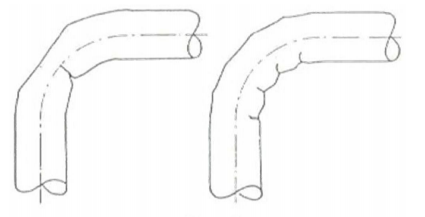The first step in troubleshooting a bend is figuring out exactly what the problem is. For instance, the word buckle could mean a bulge, collapse, distortion, or deformation of the material. Bending issues like tube wrinkling versus collapse versus bulging all have very different causes for the problem and, therefore, different solutions.
Sometimes, you can experience multiple problems with the same bend. For instance, the collapse of the tube with wrinkling throughout the entire bend.
Let's begin with one of the more common scenarios that are often referred to as buckling.
Kinked or Buckled Bends Resulting from Material Strength
One of the most commonly referred to issues, often described as a buckled bend, occurs because the material being bent is very hard. A hard material, when bent, might not compress properly on the bend's inside radius, which can cause deformations in the figure below.
As with most bend problems, the first step should always be to check your tooling. Tooling must be set properly for a bend to be executed correctly, and incorrectly set tooling is the most common reason for bend problems. So, even if you believe your tooling is correct, we recommend reviewing proper tooling placement first.
Often, when the tooling is correctly set, this tube bending issue can be solved with a plug mandrel. A plug mandrel is indicated if the tube buckles and is still within the wall factor and the diameter of the bend.
A plug mandrel is specifically designed to prevent the tube from flattening and bending without wrinkles and kinks. The mandrel is held in a fixed position while the tube is pulled over it. The tube stretching process is localized on the outer radius of the bend, and the material is work-hardened to retain its shape and not flatten.
The material stretching is done on the forward tip of the mandrel. This force, acting on the mandrel tip, supports the inner radius of the bend, holding it firmly into the bend die groove.
A plug mandrel can be used to produce relatively good quality bends for tubing 3/8î diameter and smaller. Exceptions to this are thin wall tubing or a center line radius that is less than 2 x tube O.D. There also are certain limitations for tubes larger than 3/8î diameter.
What About Other Types of Tube Bending Problems?
As mentioned above, there are other types of tube bending issues or problems that might also be referred to as buckling. It is important that you know the specific type of problem when trying to troubleshoot the issue.
For instance, you can reference this article if you are looking for why a tube might wrinkle during a bend. Looking for how to prevent a hump in your tube or tube collage, check out this article.
Learn More
Click here or follow the link below to download a free introduction to tube bending to learn more, or contact us at any time with any questions or comments you may have.

